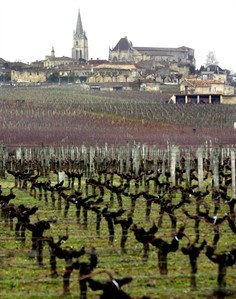
View of part of the vineyards of Saint-Emilion, southwestern France, Feb.18, 2002. THE CANADIAN PRESS/AP, Bob Edme
November 18, 2013 - 6:00 AM
SAINT EMILION, France - As visitors tread the winding cobblestone streets of the ancient French village of Saint Emilion, there's no doubt they're in wine country.
The cluster of medieval buildings atop a hill amidst the rolling vineyards of the Bordeaux region is dotted with cellars, stores and restaurants all advertising their best bottles from the UNESCO world heritage site.
Those tempted by tastings can nip into a number of speciality stores to sip their wares, others stunned by the scenery can stroll the lush vineyards that surround the village. There's even the option of descending into one of the many deep musty cellars where wine ages in row upon row of dusty bottles and barrels.
But the locals in the area say there's more to the charming village than its famous wines.
"We've got a big history. From the first century to nowadays," says Agnes Vergnaud, a guide from the local tourism office. "I'm really proud to show the real Saint Emilion to the tourists because I think it's a bad idea to think that it's just the wine."
Vergnaud fell in love with the village in southwestern France as a child, when her parents first brought the family along for a visit.
"I came back here, year after year with my parents and then when I was a teenager, with my friends, and now I'm a guide here," says Vergnaud, who now lives in the area.
What drew her to return time and again was the village's rich history and strong character.
"Saint Emilion is a small village, a typical one," Vergnaud explains. "I think it's one of the reasons that so many people like to come here to walk around. Because it's totally authentic."
Visitors soak in some of that authenticity as they traverse the steep "tertres" or laneways that are too narrow for modern vehicles, feast on local fare in the main village square and run their hands along the sides of sun-baked stone buildings that have stood for hundreds of years.
For those who want to learn more about the area's storied past, walking tours allow access to the simple underground dwelling of the monk who gave the village its name and to some of the shadowy catacombs once traversed by religious pilgrims. Other architectural gems include the village's imposing ramparts, the ruins of a monastery and the remnants of a convent.
Saint Emilion also boasts Europe's largest monolithic church — a building at the heart of the village which was carved from a hillside between the end of the 11th century and the beginning of the 12th century. The structure, which doesn't look like much from the outside, is cavernous on the inside, with visitors craning their necks to take in faded, ancient artwork on the high ceiling. A climb to the church's bell tower offers breathtaking views of the village and the picturesque countryside that surrounds it.
For a local guide like Vergnaud, strolling through the village is sometimes like stepping back in time — a feeling she tries to share with visitors.
"When I'm going inside the chapel, inside the catacombs, inside the Catholic church, inside the monolithic church, I like to imagine how it was before," she says. "And when I can imagine that, I try to show that to my tourists."
The structures which allow visitors to easily picture the past do, however, owe their preservation to the region's long-running wine industry.
"Through the French Revolution and through the other wars we were quite preserved because of the wine," says Vergnaud with a chuckle. "During the First and the Second World War the Germans really liked our wine and really didn't want to damage it."
With the vineyards intrinsically linked to Saint Emilion's history, Vergaud hopes those visiting the region will appreciate all aspects of the village.
"If Saint Emilion is famous around the world, it's because of the wine," she says. "But to my mind, I'm a guide from Saint Emilion and it's one of my responsibility to show the real Saint Emilion."
___
If you go:
Trains run from the city of Bordeaux to Saint Emilion. The journey takes about 40 minutes. The Saint Emilion train station is about a 15 minute walk from the village. http://www.raileurope-world.com/
A variety of multilingual tours are offered by the Saint Emilion tourism office year round: http://saint-emilion-tourisme.com/
News from © The Canadian Press, 2013